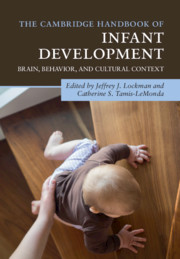Book contents
- The Cambridge Handbook of Infant Development
- The Cambridge Handbook of Infant Development
- Copyright page
- Dedication
- Contents
- Illustrations
- Contributors
- Preface
- Part I Foundations
- 1 Embodied Brain Model for Understanding Functional Neural Development of Fetuses and Infants
- 2 Infant Physical Growth
- 3 Dynamic Epigenetic Impact of the Environment on the Developing Brain
- 4 Brain Development in Infants
- 5 Development During Infancy in Children Later Diagnosed with Autism Spectrum Disorder
- Part II Perceptual Development
- Part III Cognitive Development
- Part IV Action
- Part V Language
- Part VI Emotional and Social Development
- Index
- References
3 - Dynamic Epigenetic Impact of the Environment on the Developing Brain
from Part I - Foundations
Published online by Cambridge University Press: 26 September 2020
- The Cambridge Handbook of Infant Development
- The Cambridge Handbook of Infant Development
- Copyright page
- Dedication
- Contents
- Illustrations
- Contributors
- Preface
- Part I Foundations
- 1 Embodied Brain Model for Understanding Functional Neural Development of Fetuses and Infants
- 2 Infant Physical Growth
- 3 Dynamic Epigenetic Impact of the Environment on the Developing Brain
- 4 Brain Development in Infants
- 5 Development During Infancy in Children Later Diagnosed with Autism Spectrum Disorder
- Part II Perceptual Development
- Part III Cognitive Development
- Part IV Action
- Part V Language
- Part VI Emotional and Social Development
- Index
- References
Summary
Development is a dynamic process shaped by the interactions between genes and environments. Within the field of developmental biology, the complex interactions between genes and their products that create the foundation for cellular differentiation and the formation of the nervous system have been well described. Advances in molecular biology have permitted increasing precision in the characterization of the cascade of molecular changes that link genes to specific developmental endpoints. However, beyond addressing questions regarding the processes linking a gene to a phenotypic outcome, description of these molecular changes has also provided insight into the ways in which the environment induces lasting biological effects. Though environments – particularly characteristics of the social world around us – are typically viewed as a separate and distinct influence from genes, there is increasing understanding of the interplay between genes and environments.
Information
- Type
- Chapter
- Information
- The Cambridge Handbook of Infant DevelopmentBrain, Behavior, and Cultural Context, pp. 70 - 93Publisher: Cambridge University PressPrint publication year: 2020
